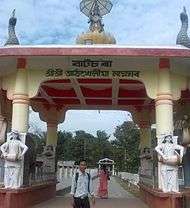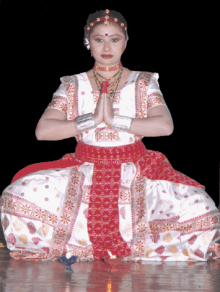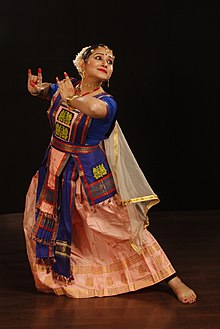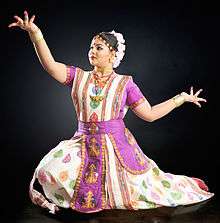Sattriya
Sattriya (Assamese: সত্ৰীয়া), or Sattriya Nritya, originated in the eastern state of Assam.[1][2] It is a dance-drama performance art with origins in the Krishna-centered Vaishnavism monasteries of Assam, and attributed to the 15th century Bhakti movement scholar and saint Mahapurush Srimanta Sankardev.[1][3][4]

One-act plays of Sattriya are called Ankiya Nat, which combine the aesthetic and the religious through a ballad, dance and drama.[5][6] The plays are usually performed in the dance community halls (namghar[6]) of monastery temples (sattras).[7] The themes played are related to Lord Krishna, sometimes other Vishnu avatars such as Rama and Sita [8] and stories from epics like Mahabharata and Ramayana are also referred to. It is to be mentioned that the philosophic religion of Mahapurush Srimanta Sankaradeva was on the basis of the Vedanta, Bhagavad Gita and the Bhagavad Puran, so there is no presence of Radha in Sattriya dance presentations.
Recognized in 2000 as a classical dance by Sangeet Natak Akademi of India, modern Sattriya explores many themes and plays, and its performances staged worldwide.[9]
History
Sattriya is a classical dance of India, a classification that traces its roots to ancient drama and music texts of India, particularly the Natya Shastra.[10][11] The Natya Shastra is a foundational treatise on the performing arts attributed to the ancient scholar Bharata Muni. Its first complete compilation is dated to between 200 BCE and 200 CE,[12][13] but estimates vary between 500 BCE and 500 CE.[14] The most studied version of the Natya Shastra text consists of about 6000 verses structured into 36 chapters.[12][15] The text, states Natalia Lidova, describes the theory of Tāṇḍava dance (Shiva), the theory of rasa, of bhāva, expression, gestures, acting techniques, basic steps, standing postures – all of which are part of Indian classical dances.[12][16] Dance and performance arts, states this ancient text,[17] are a form of expression of spiritual ideas, virtues and the essence of scriptures.[18]
The history of dance arts in Assam go back into antiquity, as evidenced by copper plate inscriptions and sculpture relating to Shaivism and Shaktism traditions.[19] Singing and musical traditions, similarly, have been traced to Assamese chorus singing tradition for the Hindu epics the Ramayana and the Mahabharata.[19]

The modern form of Sattriya is attributed to the 15th century Sankaradeva, who systematized the dance using the ancient texts, and introduced drama and expressive dancing (nritta and nritya) as a form of a community religious art for emotional devotion to Krishna.[3][7][19]
Since the 15th century, the Sattriya art grew as part of the Vaishnava bhakti movement, in Hindu monasteries called Sattra.[7] The art was developed and practiced by monks in the form dance-dramas about legends and mythologies of Krishna, particularly from texts such as the Bhagavata Purana.[20] One distinctive part of the Sattriya dance inside temples and monasteries is that the dance is not celebrated before any idol, but is performed before a copy of the Bhagavata Purana placed in eastern (sun rise) corner called Manikut of the dance hall (namghar).[20]
These dance-dramas were, in the early days, written and directed by the Assamese poet-saint Sankaradeva, and by his principal disciple Madhavadeva. They were mostly composed during the 16th century.[21] Once the domain of male monks, it is now performed by male as well as female dancers. In the second half of the 20th century, Sattriya Nritya moved from the sanctum of Assam's sattras/monasteries to the metropolitan stage.[22]
The Sangeet Natak Akademi recognized Sattriya Nritya as an official classical dance of India in 2000. Sattriyas are now performed on world's stages.[21]
Repertoire


Like the other schools of Indian Classical dance, Sattriya encompasses the principles required of a classical dance form: the treatises of dance and dramaturgy, like Natya Shastra, Abhinaya Darpana, and Shakaradeva's Sangit Ratnakara;[23] The Sangit Ratnakara of Shankaradeva complements his Bhakti Ratnakara, which traces the Upanishads, Bhagavad Gita, Yoga and Vedanta themes, the ethical values such as non-violence (ahimsa), truthfulness (satya) and others, thus premising a theological foundation to Sattriya.[24] To Shankaradeva, religious values, ethics, joys of life and performance arts were intimately linked, and he asked the leaders of Hindu monasteries to compose at least one play, during their tenure, before they die.[4]
Sattriya repertoire (marg) includes nritta (pure dance, solo), nritya (expressive dance, solo), and natya (dramatic play, group). Like all major classical Indian dance forms, those three categories of performances are:[25][26]
- The Nritta performance is abstract, fast and rhythmic aspect of the dance.[27][28] The viewer is presented with pure movement in Nritta, wherein the emphasis is the beauty in motion, form, speed, range and pattern. This part of the repertoire has no interpretative aspect, no telling of story.[29]
- The Nritya is slower and expressive aspect of the dance that attempts to communicate feelings, storyline particularly with spiritual themes.[27][28] In a nritya, the performance expands to include story-telling, the silent expression of words through gestures and body motion set to musical notes. This part of a repertoire is more than sensory enjoyment, it aims to engage the emotions and mind of the viewer.[29]
- The Natya is a play, typically a team performance, but can be acted out by a solo performer where the dancer uses certain standardized body movements to indicate a new character in the underlying story. A Natya incorporates the elements of a Nritya.[28] Kuchipudi, in its history relied on a team a dance-actors, while in modern times Kuchipudi productions include solo or duo performances.[30]
The hand gestures (mudras), footwork (padas), postures, rhythms, training of artists and other aspects of the Sattriya dance drama closely follow those described in Natya Shastra and other classical Hindu dance texts, and are quite similar to other major classical dances such as Odissi, Kathakali, Bharatanatyam and others found in south and north India.[8][31] Some basic elements and features of Sattriya match those found in the Manipuri dance found in neighboring Manipur state.[32]
Sattriya Nritya is a genre of dance drama that tells mythical and religious stories through hand and face expressions. The basic dance unit and exercise of a Sattriya is called a Mati Akhara, equal 64 just like in Natya Shastra, are the foundational sets dancers learn during their training. The Akharas are subdivided into Ora, Saata, Jhalak, Sitika, Pak, Jap, Lon and Khar. A performance integrates two styles, one masculine (Paurashik Bhangi, energetic and with jumps), and feminine (Stri Bhangi, Lasya or delicate).[33]
Traditionally, Sattriya was performed only by bhokots (male monks) in monasteries as a part of their daily rituals or to mark special festivals. Today, in addition to this practice, Sattriya is also performed on stage by men and women who are not members of the sattras, on themes not merely mythological.
The plays choreographed in a Sattriya are those found in Hindu texts such as the Bhagavata Purana, the Epics, and the compositions by Assamese scholars. The stories related to the love between Radha and Krishna are particularly common.[8]
Costumes


The costume of Sattriya dance is primarily of two types: the male costume comprising the dhoti and chadar and the paguri ( turban) and the female costume comprising the ghuri, chadar and kanchi (waist cloth). Traditionally the costumes were of white or raw silk color with use of red, blue and yellow for specific dance numbers. In earlier times velvet and satin materials were mostly used for the costumes. With change of time, as this dance form evolved from the sattras onto stage, the design and materials of the dance costumes changed. Pat (also spelled paat) – a silk produced in Assam which is derived from the mulberry plant and muga silk( golden silk of Assam) is also used in preparing the dance costume. Other brilliant colours are also used in the female costumes. These hand-woven materials normally have intricate local motifs like Kingkhap, Miri Motif, Kolka etc.[34][35]
Uses of play-specific costumes are also seen in Sattriya dance. The dress of Krishna Nritya and Nadubhangi Nritya is of yellow and blue keeping in line with the attire of Lord Krishna. The Sutradhar Nritya also has its specific white costume with a special turban.
Traditional Assamese jewellery is used in Sattriya dance. The jewelleries are made in a unique technique in Kesa Sun ( raw gold). Artists wear Kopali on the forehead, Muthi Kharu and Gam Kharu (bracelets), different type of neck pieces like Mata Moni (for male dancers), Golpata, Dhulbiri (shaped like the musical instrument dhol), Bena (pendant shaped like a crescent), Jethipata (lizard shaped), Dugdugi (leaf shaped), Senpata (eagle shaped), Dhansira (strand of rice grain), Lokaparo (pegion design). Earrings are made in similar designs and also Thuka Suna and Keru are worn by dancers. Female dancers wear white flowers in the hair.[34][35]
The costumes of Ankiya Naats (dramas) are colourful and character specific. Use of Mukha (Masks) to depicts demons and special characters are also unique of this dance form. The art of mask making is an integral part of Sattriya culture and originated in the Sattras of Assam. Beautifully decorated turbans and crowns made by the local artisans are used in the Ankiya Naats.[34][35]
The facial makeup of Sattriya dance resembles other classical dance forms of India. However, in earlier times traditional materials and herbs were used for make up.[35]
Music and instruments
Sattriya Nritya is accompanied by musical compositions called borgeets (composed by Sankardeva and Shree Shree madhavdev, among others) which are based on classical ragas.
A key musical instrument that accompanies a Sattriya performance are khols (two faced, asymmetrical drum quite different from the rest of India) played with fingers.[36] The special shape and materials of construction – clay, wood, leather, rice dough, iron filings, rope straps – of Sattriya khol produces a high pitch with the right side (Daina), while producing a deep bass sound on the left (Bewa).[36]
Accompanying the khol are various types of Talas or cymbals (Manjira, Bhortal, Bihutal, Patital, Khutital) and the flute (bansuri). Other instruments like the violin and the harmonium have been recent additions.[36][note 1]
Styles
A Sattriya performance comes in many styles such as the Sutradhara (or Sutra-bhangi), character specific Bhangi, Prabesh, Nritya and Jhumura.[8] The Sutradhara is a style that tells a story and presents the spiritual values of Vaisnavism in a complete classical format: nritta, nritya and natya. One feature of the Sutradhara (or Sutradhari) style is the included commentary for the audience in local language.[38]
Ankiya Nat is a subgenre consisting of one-act plays of Sattriya. These are dedicated compositions but feature a ballad, dance and drama.[5][6]
The character specific different styles of Sattriya have their own costume variations, and focus on the various life stages and activities of Radha, Krishna and the gopis.[33]
Schools and training
Over the years, Sattriya Nritya has received greater acceptance and patronage both outside the state of Assam, and outside India..One of the Sattriya Nritya dancer promoting the dance art overseas is Madam Kavitha Supramaniam from Malaysia. Madam Kavitha Supramanaim as an accomplish dancer; learning the art under close guidance of her esteem teacher Preeti Chowdhury of Assam.

List of Sattriya dance schools outside Assam
- Sattriya Nrityasala (a unit of Satkara-Unleashing the Spirit of Sattriya) run by Meenakshi Medhi in New Delhi.
- Adi School of Dance run by Dr. Devika Borthakur in Pune.
- Sattriya Sanskriti Kendra run by Asom Sattra Mahasabha, Gurugram.
Notes
- In some compositions, the following additional regional musical instruments, adopted from regional folk dances, complete the orchestra: Bin, Tokari, Dotara, Nagara and different styles of drums (mrdanga, dhol, dambaru, etc).[37]
References
- Frank Burch Brown (2014). The Oxford Handbook of Religion and the Arts. Oxford University Press. pp. 193–195. ISBN 978-0-19-517667-4.
- Williams 2004, pp. 83-84, the other major classical Indian dances are: Bharatanatyam, Kathak, Odissi, Kathakali, Kuchipudi, Cchau, Manipuri, Yaksagana and Bhagavata Mela.
- Shovana Narayan (2011). The Sterling Book of INDIAN CLASSICAL DANCE. Sterling Publishers. pp. 73–74. ISBN 978-81-207-9078-0.
- Farley P. Richmond, Darius L. Swann & Phillip B. Zarrilli 1993, p. 22.
- Ankiya Nat, UNESCO: Asia-Pacific Database on Intangible Cultural Heritage (ICH), Japan
- Lavanya Vemsani (2016). Krishna in History, Thought, and Culture: An Encyclopedia of the Hindu Lord of Many Names. ABC-CLIO. pp. 12–13. ISBN 978-1-61069-211-3.
- Siyuan Liu (2016). Routledge Handbook of Asian Theatre. Routledge. pp. 19–21. ISBN 978-1-317-27886-3.
- Maheswar Neog (1980). Early History of the Vaiṣṇava Faith and Movement in Assam: Śaṅkaradeva and His Times. Motilal Banarsidass. pp. 294–299. ISBN 978-81-208-0007-6.
- Sunil Kothari (2012). Urmimala Sarkar Munsi and Stephanie Burridge (ed.). Traversing Tradition: Celebrating Dance in India. Routledge. pp. 23–24. ISBN 978-1-136-70379-9.
- Tanvi Bajaj; Swasti Shrimali Vohra (2015). Performing Arts and Therapeutic Implications. Routledge. pp. 6–7. ISBN 978-1-317-32572-7.
- Ragini Devi 1990, pp. 60-68.
- Natalia Lidova 2014.
- Tarla Mehta 1995, pp. xxiv, 19–20.
- Wallace Dace 1963, p. 249.
- Emmie Te Nijenhuis 1974, pp. 1–25.
- Kapila Vatsyayan 2001.
- Guy L. Beck (2012). Sonic Liturgy: Ritual and Music in Hindu Tradition. University of South Carolina Press. pp. 138–139. ISBN 978-1-61117-108-2.
Quote: "A summation of the signal importance of the Natyasastra for Hindu religion and culture has been provided by Susan Schwartz, "In short, the Natyasastra is an exhaustive encyclopedic dissertation of the arts, with an emphasis on performing arts as its central feature. It is also full of invocations to deities, acknowledging the divine origins of the arts and the central role of performance arts in achieving divine goals (...)".
- Coormaraswamy and Duggirala (1917). "The Mirror of Gesture". Harvard University Press. p. 4.; Also see chapter 36
- Maheswar Neog (1980). Early History of the Vaiṣṇava Faith and Movement in Assam: Śaṅkaradeva and His Times. Motilal Banarsidass. pp. 292–293. ISBN 978-81-208-0007-6.
- Farley Richmond (2016). Siyuan Liu (ed.). Routledge Handbook of Asian Theatre. Routledge. pp. 20–21. ISBN 978-1-317-27886-3.
- Kothari, Sunil (ed). Sattriya-Classical Dance of Assam. Marg, The Marg Foundation, Mumbai, 2013.
- Kothari, Sunil (ed). Sattriya-Classical Dance of Assam. Marg, The Marg Foundation, Mumbai, 2013, Blurb.
- Maheswar Neog (1980). Early History of the Vaiṣṇava Faith and Movement in Assam: Śaṅkaradeva and His Times. Motilal Banarsidass. pp. 208–221. ISBN 978-81-208-0007-6.
- Maheswar Neog (1980). Early History of the Vaiṣṇava Faith and Movement in Assam: Śaṅkaradeva and His Times. Motilal Banarsidass. pp. 209, 222–229, 233–234. ISBN 978-81-208-0007-6.
- Shovana Narayan (2011). "Kuchipudi". The Sterling Book of Indian Classical Dance. Sterling. pp. 48–49. ISBN 978-81-207-9078-0.
- Reginald Massey 2004, pp. 83-84.
- Ellen Koskoff (2008). The Concise Garland Encyclopedia of World Music: The Middle East, South Asia, East Asia, Southeast Asia. Routledge. p. 955. ISBN 978-0-415-99404-0.
- Reginald Massey 2004, pp. 33-38, 83-84.
- Janet Descutner (2010). Asian Dance. Infobase. pp. 45–46. ISBN 978-1-4381-3078-1.
- Bruno Nettl; Ruth M. Stone; James Porter; et al. (1998). The Garland Encyclopedia of World Music: South Asia : the Indian subcontinent. Routledge. pp. 516–518. ISBN 978-0-8240-4946-1.
- Shovana Narayan (2011). The Sterling Book of Indian Classical Dance. Sterling Publishers. pp. 74–75. ISBN 978-81-207-9078-0.
- Maheswar Neog (1980). Early History of the Vaiṣṇava Faith and Movement in Assam: Śaṅkaradeva and His Times. Motilal Banarsidass. p. 298. ISBN 978-81-208-0007-6.
- Sunil Kothari (2013). Sattriya: Classical Dance of Assam. Marg Foundation. ISBN 978-81-921106-6-0.
- P.N. Sundaresan (1999). Sruti, A Monthly Magazine on Indian Performing Arts. 172-183. pp. 40–41.
- "Costume | Krishnakshi Kashyap". www.sattriyakristi.com. Retrieved 11 February 2018.
- Dilip Ranjan Barthakur (2003). The Music and Musical Instruments of North Eastern India. Mittal Publications. pp. 81, 89–90. ISBN 978-81-7099-881-5.
- Dilip Ranjan Barthakur (2003). The Music and Musical Instruments of North Eastern India. Mittal Publications. pp. 11–12. ISBN 978-81-7099-881-5.
- Lavanya Vemsani Ph.D. (2016). Krishna in History, Thought, and Culture. ABC-CLIO. pp. 12–13. ISBN 978-1-61069-211-3.
Bibliography
- Sunil Kothari, ed., Sattriya, Classical Dance of Assam, with photographs by Avinash Pasricha. The Marg Foundation, Mumbai, 2013. ISBN 978-81-921106-6-0
- Williams, Drid (2004). "In the Shadow of Hollywood Orientalism: Authentic East Indian Dancing" (PDF). Visual Anthropology. Routledge. 17 (1): 69–98. doi:10.1080/08949460490274013.CS1 maint: ref=harv (link)
- Neog, Maheswar. Aesthetic Continuum: Essays on Assamese Music, Drama, Dance and Paintings. New Delhi: Omsons Publications, 2008.
- Neog, Maheswar and Keshav Changkakati. Sattriya Dances of Assam and their Rhythms. Guwahati: Assam Prakashan Parishan, 1973.
- Ragini Devi (1990). Dance Dialects of India. Motilal Banarsidass. ISBN 978-81-208-0674-0.CS1 maint: ref=harv (link)
- Natalia Lidova (2014). "Natyashastra". Oxford University Press. doi:10.1093/obo/9780195399318-0071. Cite journal requires
|journal=(help)CS1 maint: ref=harv (link) - Natalia Lidova (1994). Drama and Ritual of Early Hinduism. Motilal Banarsidass. ISBN 978-81-208-1234-5.
- Williams, Drid (2004). "In the Shadow of Hollywood Orientalism: Authentic East Indian Dancing" (PDF). Visual Anthropology. Routledge. 17 (1): 69–98. doi:10.1080/08949460490274013.CS1 maint: ref=harv (link)
- Tarla Mehta (1995). Sanskrit Play Production in Ancient India. Motilal Banarsidass. ISBN 978-81-208-1057-0.CS1 maint: ref=harv (link)
- Reginald Massey (2004). India's Dances: Their History, Technique, and Repertoire. Abhinav Publications. ISBN 978-81-7017-434-9.CS1 maint: ref=harv (link)
- Emmie Te Nijenhuis (1974). Indian Music: History and Structure. BRILL Academic. ISBN 90-04-03978-3.CS1 maint: ref=harv (link)
- Kapila Vatsyayan (2001). Bharata, the Nāṭyaśāstra. Sahitya Akademi. ISBN 978-81-260-1220-6.CS1 maint: ref=harv (link)
- Kapila Vatsyayan (1977). Classical Indian dance in literature and the arts. Sangeet Natak Akademi. OCLC 233639306., Table of Contents
- Kapila Vatsyayan (1974). Indian classical dance. Sangeet Natak Akademi. OCLC 2238067.
- Kapila Vatsyayan (2008). Aesthetic theories and forms in Indian tradition. Munshiram Manoharlal. ISBN 978-8187586357. OCLC 286469807.
- Kapila Vatsyayan. Dance In Indian Painting. Abhinav Publications. ISBN 978-81-7017-153-9.
- Wallace Dace (1963). "The Concept of "Rasa" in Sanskrit Dramatic Theory". Educational Theatre Journal. 15 (3): 249. doi:10.2307/3204783. JSTOR 3204783.CS1 maint: ref=harv (link)
- Farley P. Richmond; Darius L. Swann; Phillip B. Zarrilli (1993). Indian Theatre: Traditions of Performance. Motilal Banarsidass. ISBN 978-81-208-0981-9.CS1 maint: ref=harv (link)
External links
| Wikimedia Commons has media related to Sattriya. |
- Sattriya Dance at www.sattriyakristi.com website.
